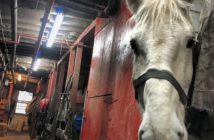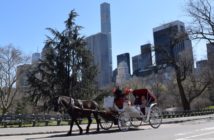(Click here to open the meme in a format suitable for downloading and sharing.)
One of the most common criticisms of NYC carriage horses is that they “live a nose-to-tailpipe existence” and therefore, say the animal rights extremists, carriage horses must be banned and removed to the “country” where they will not “suffer from respiratory issues.”
This is nonsense. There is no empirical evidence to suggest that carriage horses are harmed by the air in Manhattan.
Equine veterinarians have repeatedly noted upon examining the carriage horses in NYC that they do not exhibit evidence of respiratory illness, especially compared to similar populations of stabled horses.
Dr. John E. Lowe, examining 130 carriage horses in 2008, observed, “Once again I spent 10 hours with these horses and didn’t hear one cough at the jog or in the stables. This is an unusual observation for stalled horses. The development of respiratory allegories is almost a given in a percentage of stabled horses.”
Why is that?
First we need to understand what causes respiratory illness in horses. The main cause of respiratory distress in horses is poorly ventilated stables and/or stables with poor hygiene. Carriage horse stables are extremely well-ventilated. Every NYC carriage stable was built as a stable, and as such, has lots of natural ventilation in the form of windows on all sides of the buildings. Furthermore, as the stables were modernized, the carriage owners added additional ventilation, in the form of industrial fans and exhaust systems. Finally, NYC carriage stables are kept clean by a 24-hour-a-day crew of stablemen who make sure that the ammonia fumes from soiled bedding that irritate lungs are never allowed to build up. Dr. Stephen O’Grady attested to the air quality and cleanliness of Clinton Park Stables during a visit in 2013:
While the law requires that the stables and stalls must be clean and dry, O’Grady was surprised to the extent that workers carried out that mandate.
“When you walk into stables, a lot of times they’ll have a smell to them,” says the International Equine Veterinarian Hall Of Fame member. “In other words, they smell like a barn. They smell like horses. They smell like horse manure. During my visit, when you walked into this place, there was no smell whatsoever.”
As anyone who spends any significant amount of time in a barn, this is no easy feat, O’Grady says.
“You could not get the smell out of there in a week to 10 days if you tried,” he says. “This is just another indication as to the conditions and cleanliness in which these horses are housed.”
Animal rights extremists often talk about “toxic fumes” that carriage horses inhale all day from being “nose-to-tailpipe” with cars. Dr. Harry Werner, past president of the American Association of Equine Practitioners, found no evidence of respiratory disease when he examined the carriage horses in 2010.
A common refrain among critics of the carriage horse industry is that the animals are “nose-to-tail pipe” with traffic and, as a result, there is a health hazard.
“I don’t disagree that city air is not the same quality as it is on the front range of the Rockies,” Werner says. “However, if that is a factor to consider, then one would expect to see some evidence of respiratory disease in these horses.”
The symptoms include rapid respiratory rate, shallow respiratory rate, heaving, nasal discharge, coughs or any evidence of respiratory abnormality.
“We didn’t see a one,” Werner says. “If people are worried about air quality, fine, let’s worry about air quality. Where’s your evidence? Evidence is key to all of this.”
First of all, carriage horses spend relatively little time in traffic. When they do, their noses are not anywhere near the tailpipes of cars. “Nose-to-tailpipe” is an anatomical impossibility. The exhaust from cars does not stay right next to the tailpipe either; it diffuses. Air quality studies such as the Nantes’99 study in France have used fluid dynamics to show that in urban areas, particularly in so-called “street canyons” (such as you’ll find in New York), the air is frequently cleaner in the flow of traffic than on the sidewalk or in neighboring buildings where pollutants accumulate, due to prevailing winds.
In 2013, the City of New York released an air quality study that showed that NYC now has the cleanest air it’s had since the 1960s. That means that NYC probably has the cleanest air it’s had since before the industrial revolution. Sulfur dioxide levels had dropped 69 percent since 2008 and soot pollution was down 23 percent since 2007. Most of this improvement stemmed from reducing pollution from the dirtiest kinds of heating oil that are still being used in the city. New York City has already reaped the benefits of reducing pollution from automobile traffic, insofar as cars continue to improve their emissions (and have over the past 40 years) and the number of cars driving into Manhattan on a daily basis has dropped 29 percent since 1998, to 1980 levels (which were 2.5% less than 1960 levels).
So as the air quality in New York continues to improve, so what’s the big hurry to get rid of carriage horses? Animal rights extremists claim that despite evidence that air quality is improving to levels not seen in a half-century or more, carriage horses would be better off breathing “fresh country air.” But is the air outside NYC really all that clean? Turns out the answer is no.
The American Lung Association conducts annual surveys of air quality throughout the country, by county, in its “State of the Air” report. New York County (Manhattan) has cleaner air than both Hunterdon County, NJ (where NYCLASS President Steve Nislick keeps his horses) and Lancaster County, PA (where the carriage horses go on vacation.
Even if the air were horrendously polluted in New York City (and it’s not, especially not compared to the 19th century), it’s still the same air that we breathe and that our children and our pets breathe. If we want to protect carriage horses from the air they breathe, the solution is not to banish carriage horses to farms where the air is no cleaner, but rather to continue to improve the air in New York City and everywhere. That would do us all some good.
In the meantime, breathe easy. The carriage horses are fine. That’s a breath of fresh air next to the nonsense spewed by animal extremists.




